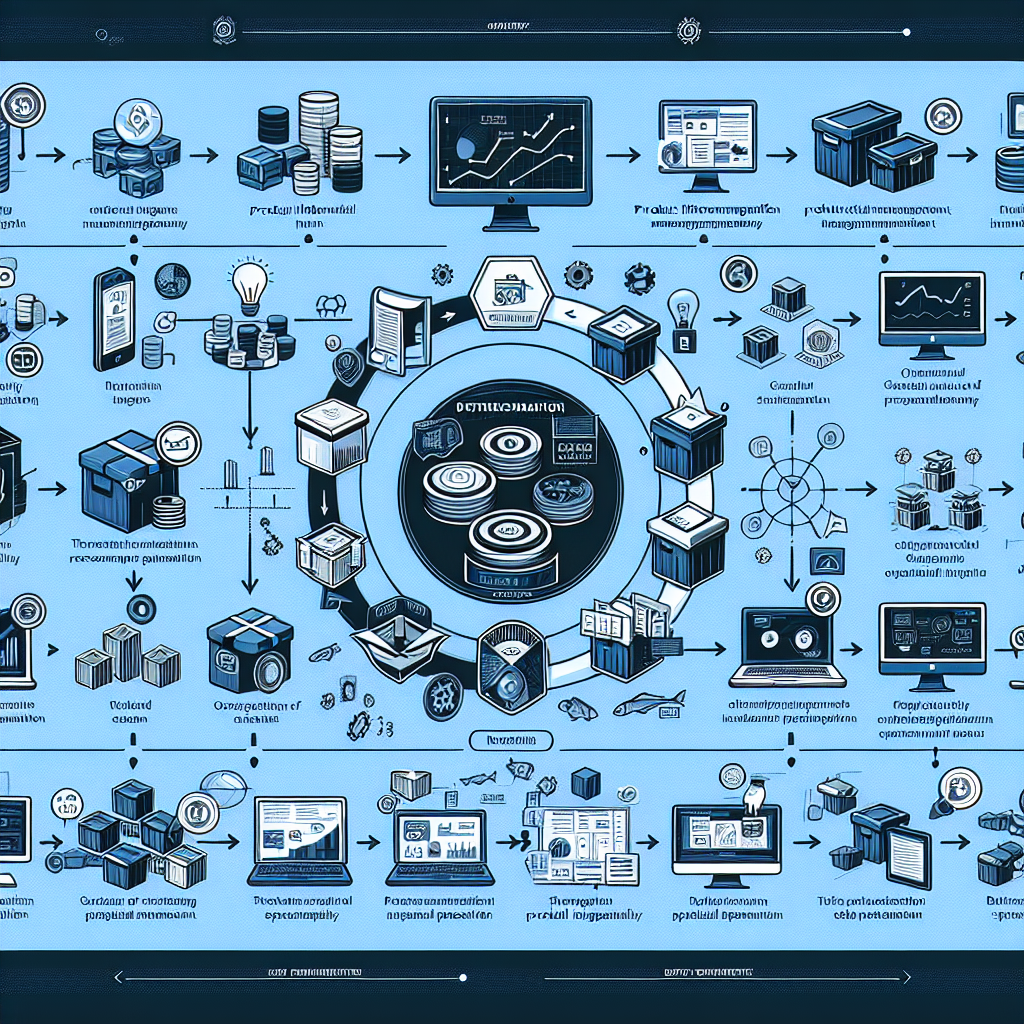In today’s digital commerce landscape, creating compelling product experienceshas become a critical differentiator. Customers no longer make purchasingdecisions based solely on product features or price—they expect rich,informative, and visually engaging content that builds confidence and emotionalconnection.Behind the scenes of these exceptional product experiences lies a powerfultechnological synergy between two essential systems: Product InformationManagement (PIM) and Digital Asset Management (DAM).DAM platforms help organizations manage and share digital brand content, such as productimages and marketing materials. They serve as central hubs for maintaining brandconsistency and facilitating access to essential digital assets.This article explores how the integration of these complementary systems createsa foundation for delivering superior product experiences across all channels,driving engagement, conversion, and brand loyalty.UNDERSTANDING THE ESSENTIAL SYSTEMSBefore examining their synergistic relationship, let’s clarify the distinctroles these systems play in the digital commerce ecosystem:Selecting the right software solutions is crucial for effectively managing bothPIM and DAM systems, ensuring seamless integration and optimal performance.PRODUCT INFORMATION MANAGEMENT (PIM)PIM systems specialize in centralizing, organizing, and distributing thecomplete spectrum of product data, including: * Basic product information (names, descriptions, identifiers) * Technical specifications and material details * Pricing and promotional information * Logistical data (dimensions, weight, packaging) * Category classifications and relationships * Marketing content and messagingThe primary purpose of PIM is to create a “single source of truth” for allproduct-related information, ensuring consistency and accuracy across all salesand marketing channels. PIM platforms play a crucial role in managing anddistributing product information, integrating with various external tools toenhance scalability and drive content ROI.DIGITAL ASSET MANAGEMENT (DAM)DAM systems serve as the central repository for organizing and managing alldigital media assets, including: * Product photography (lifestyle and technical) * Videos and animations * Audio files * Diagrams and technical illustrations * Documents (brochures, manuals, specifications) * Brand assets and marketing materialsA DAM platform plays a crucial role in organizing, managing, and sharing digitalbrand content, ensuring brand consistency across various marketing channels.DAM ensures that the right digital assets are easily accessible, properlyversioned, and correctly formatted for various channels and use cases.THE DIFFERENCE BETWEEN PIM AND DAM SYSTEMSPIM (Product Information Management) and DAM (Digital Asset Management) systemsare two distinct solutions that cater to different aspects of product management. While both systems areessential for businesses, especially those in the e-commerce and retail sectors,they serve different purposes and offer unique features.PIM systems are designed to manageproduct information, including product descriptions, specifications, pricing,and inventory levels. These systems act as a central repository for productdata, ensuring that all stakeholders have access to accurate and up-to-dateinformation. PIM systems are particularly useful for businesses with complexproduct catalogs, as they enable the efficient management of product data acrossmultiple sales and marketing channels.On the other hand, DAM systems are focused on managing digital assets, such asimages, videos, and documents. These systems provide a centralized platform forstoring, organizing, and distributing digital assets, making it easier forbusinesses to maintain brand consistency and ensure that the right assets areused across different channels. DAM systems are particularly useful for creativeteams, as they enable the efficient management of rich media assets and providefeatures such as version control and collaboration tools.In summary, PIM systems are designed to manage product information, while DAMsystems are focused on managing digital assets. Both systems are essential forbusinesses, and integrating them can provide a comprehensive solution formanaging product data and digital assets.PIM FEATURES AND FUNCTIONALITYPIM systems offer a range of features and functionality that enable businessesto efficiently manage product information. Some of the key features of PIMsystems include: 1. Product Data Management: PIM systems provide a centralized platform for managing product data, including product descriptions, specifications, pricing, and inventory levels. 2. Product Categorization: PIM systems enable businesses to categorize products based on various attributes, such as product type, brand, and category. 3. Product Variation Management: PIM systems allow businesses to manage different variations of products, including size, color, and material. 4. Product Syndication: PIM systems enable businesses to syndicate product data to multiple sales and marketing channels, including e-commerce platforms , social media, and print catalogs. 5. Data Governance: PIM systems provide features such as data validation , data normalization, and data enrichment to ensure that product data is accurate and consistent. 6. Integration with Other Systems: PIM systems can be integrated with other systems, such as ERP, CRM, and e-commerce platforms, to provide a comprehensive solution for managing product data.Overall, PIM systems provide a range of features and functionality that enablebusinesses to efficiently manage product information and ensure that accurateand up-to-date information is available to all stakeholders.THE POWER OF PIM-DAM INTEGRATIONWhile each system is valuable independently, their integration creates amultiplicative effect that transforms how organizations manage and leverageproduct content. PIM and DAM integration is essential for improving data andasset management, enhancing workflows, ensuring consistency in customerexperiences, and creating a unified source of truth.1. CREATING A UNIFIED CONTENT REPOSITORYIntegration between PIM and DAM—whether through native functionality inplatforms like Pimcore or through connectors between specialized systems likeAkeneo and Bynder—establishes a single, comprehensive repository for bothstructured product data and rich media assets.This unified approach eliminates information silos that plague manyorganizations, where product data and digital assets exist in separate systemsmanaged by different teams. With integration, a product manager can instantlysee all assets associated with a particular product, while creative teams caneasily identify which products require updated imagery or videos. Additionally,these integrated systems serve as a central hub for managing content, promotingefficient workflows and collaboration among teams.2. ENSURING PERFECT CONTENT ALIGNMENTPerhaps the most significant advantage of PIM-DAM synergy is the assurance thatthe right assets are always connected to the right products. This criticalalignment ensures: * Product listings always feature current, approved images * Technical specifications match the exact product variant being displayed * Marketing materials remain consistent with the latest product information * Brand messaging maintains coherence across all product representations * Product images are always current and approvedThis alignment is particularly valuable for products with multiple variants,seasonal updates, or frequent specification changes, where mismatchedinformation and imagery can lead to customer confusion and lost sales.3. STREAMLINING OPERATIONAL WORKFLOWSThe integration of PIM and DAM dramatically improves operational efficiency by: * Eliminating duplicate work in managing related content across separate systems * Creating unified workflows that span both product information and digital assets * Reducing the need to manually match assets with product data * Providing a single interface for updating both types of content simultaneouslyThis streamlined approach can reduce time-to-market for new products by up to50%, according to industry analyses, by eliminating data silos and optimizingcontent creation and publication processes. Additionally, this integrationenables a faster time to market for new products, givingbrands a competitive advantage and increasingrevenue.4. ENSURING BRAND CONSISTENCYWhen product information and digital assets are managed in isolation,maintaining consistent brand presentation becomes challenging. The synergybetween PIM and DAM ensures that: * Product messaging aligns with visual presentation * Brand guidelines are consistently applied across all content * Updates to brand identity can be implemented holistically * Regional or channel-specific adaptations maintain core brand integrityThis consistency builds trust with customers who encounter the brand acrossmultiple touchpoints, reinforcing brand recognition and perceived quality.Additionally, PIM and DAM systems enhance brand consistency across all content.CREATING EXCEPTIONAL PRODUCT EXPERIENCESThe practical applications of PIM-DAM synergy directly translate to enhancedproduct experiences for customers:Integrating PIM and DAM systems ensures consistency in product information andmedia assets, which fosters trust and enhances the customer experience fromdiscovery to purchase.RICH, ENGAGING PRODUCT PRESENTATIONSBy combining detailed product information with high-quality visual assets,organizations can create extraordinarily compelling product presentations that: * Show products from multiple angles and in various contexts * Demonstrate product features through videos and interactive elements * Provide detailed specifications alongside visual representations * Include supporting documentation such as manuals or buying guidesCombining textual content with visual elements is crucial for creating engagingand effective product presentations.These rich presentations significantly reduce purchase uncertainty and helpcustomers make informed decisions, particularly for complex orhigh-consideration products.CONSISTENT OMNICHANNEL EXPERIENCESToday’s customers interact with products across numerous channels—websites,mobile apps ,marketplaces, social media, and physical locations. PIM-DAM integration ensuresthat regardless of where the interaction occurs: * Product information remains accurate and consistent * Visual assets maintain quality and relevance * Brand presentation retains its integrity * The overall experience feels seamless and cohesiveMaintaining accurate product information across multiple channels is crucial forproviding a consistent omnichannel experience.This consistency builds confidence in the brand and reduces friction in thecustomer journey as consumers move between channels during their decisionprocess.PERSONALIZED CONTENT DELIVERYThe combination of structured product data and diverse media assets creates afoundation for sophisticated personalization. Organizationscan leverage this integrated content to: * Present product information in ways that address specific customer needs * Highlight different features or benefits based on customer profiles * Show products in contexts relevant to particular customer segments * Adapt the depth and format of information based on the customer’s journey stageDetailed product data is essential for maintaining product consistency andsupporting businesses with extensive catalogs, which in turn enhancespersonalized content delivery.This tailored approach significantly increases engagement and conversion bymaking product experiences feel personally relevant to each customer.IMPLEMENTATION APPROACHES: INTEGRATED VS. CONNECTED SYSTEMSOrganizations typically choose between two approaches to achieving PIM-DAMsynergy: integrating separate systems or using a unified solution. Using oneplatform for both PIM and DAM can streamline updates and enhance brandconsistency, ensuring a unified brand identity and greater cohesion in marketingefforts.UNIFIED PLATFORMSPlatforms like Pimcore and Contentserv offer native integration of PIM and DAMfunctionality within a single system. This approach provides: * Seamless interaction between product data and digital assets * Unified user interface and consistent experience * Simplified implementation and maintenance * Common data model and governanceUnderstanding the differences and synergies between PIM vs DAM systems iscrucial for businesses looking to optimize their e-commerce strategies.Unified platforms are often ideal for organizations seeking to build acomprehensive solution from the ground up or replace multiple legacy systems.SPECIALIZED SYSTEMS WITH CONNECTORSAlternatively, organizations may choose best-of-breed solutions for eachfunction, connected through purpose-built integrations. For example, Akeneo PIMcan integrate with specialized DAM systems like Bynder through their “PIM x DAM”connectors. This approach offers: * Best-in-class functionality for each specific need * Flexibility to choose preferred solutions for each domain * Ability to leverage existing investments in either system * Specialized tools optimized for different team requirementsThis approach often appeals to organizations with established processes orexisting investments in either PIM or DAM systems.CASE STUDY: TRANSFORMING PRODUCT EXPERIENCE THROUGH INTEGRATIONA leading home furnishings retailer illustrates the impact of PIM-DAM synergy.Before integration, they managed over 15,000 SKUs with product information inspreadsheets and ERP systems, while digital assets were stored across networkdrives, design software, and email attachments. This fragmentation resulted in: * Inconsistent product listings across channels * Frequent use of outdated or incorrect imagery * Extended time-to-market for new products * Significant manual effort to maintain relationships between products and assetsAfter implementing an integrated PIM-DAM solution, they achieved: * 60% reduction in time required to launch new products * Near-perfect alignment of product information and imagery across all channels * 40% increase in conversion rates due to improved product presentation * Significant reduction in customer service inquiries related to product information * Enhanced ability to create seasonal collections and promotionsThese improvements directly translated to increased sales, reduced operationalcosts, and stronger customer loyalty. The integration of PIM and DAM systemssignificantly streamlined their business operations, ensuring accurate productinformation and facilitating smooth data migration.SELECTING THE RIGHT SOLUTIONWhen evaluating platforms to achieve PIM-DAM synergy, organizations shouldconsider several key factors:Choosing the right PIM solution is crucial as it serves as a centralizedplatform that consolidates and manages essential product information acrossvarious retail channels, maintaining brand consistency and enhancing customertrust.INTEGRATION DEPTHAssess how deeply the product information and digital assets are connected. Canassets be associated with specific product attributes? Can relationships beestablished at various levels (product family, variant, SKU)? Does the systemmaintain these relationships automatically when changes occur?Additionally, consider the importance of PIM integration with other systems,such as DAM, to enhance the organization and accuracy of product informationacross multiple sales channels.WORKFLOW CAPABILITIESEvaluate whether the solution supports integrated workflows spanning bothproduct information and digital assets. Can approval processes include both dataand media elements? Do content creation and enrichment processes align acrossboth domains? The marketing team plays a crucial role in utilizing PIM and DAMsystems to streamline workflows and ensure consistent product information acrossvarious sales channels.SCALABILITYConsider the solution’s ability to handle growing product catalogs, expandingasset libraries, and increasing complexity. Will performance remain acceptableas the volume of both product data and digital assets increases?Scalability is particularly crucial for ecommerce businesses, which need robustsystems to manage extensive product data and digital assets efficiently as theygrow.USER EXPERIENCEExamine the interface from the perspective of both product managers and creativeteams. Does it provide intuitive access to both information types? Can userseasily navigate between related products and assets?User experience is crucial for creative professionals, as it ensures efficientcollaboration and seamless management of digital assets.OUTPUT FLEXIBILITYAssess the system’s ability to deliver integrated product content to diversechannels and formats. Can it automatically optimize both information and assetsfor different contexts and platforms?Additionally, consider how the system supports the sales team by providingup-to-date product information and marketing materials through PIM and DAMsystems, enhancing their productivity and customer engagement.CONCLUSION: THE FUTURE OF PRODUCT EXPERIENCE MANAGEMENTAs digital commerce continues to evolve, the line between product informationand digital assets will increasingly blur. Customers don’t distinguish betweendata and media—they simply expect comprehensive, engaging product experiencesthat build confidence and inspire purchase decisions.The synergy between PIM and DAM systems provides the foundation for theseexceptional experiences by ensuring that all product content—both informationaland visual—is accurate, aligned, and optimized for each customer interaction.Organizations that establish this foundation gain significant competitiveadvantages in speed-to-market, operational efficiency, brand consistency, andcustomer engagement.Whether through unified platforms or connected specialized systems, theintegration of product information and digital asset management has becomeessential for creating the compelling product experiences that drive digitalcommerce success. As customer expectations continue to rise, this technologicalsynergy will only grow in strategic importance for brands and retailerscompeting in the digital marketplace. This synergy not only enhances productlistings with rich media but also facilitates exceptional customer experiences,fostering trust and increasing conversion rates.

PIM and DAM: The Powerful Synergy Creating Exceptional Product Experiences
Posted Date:





